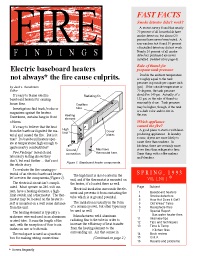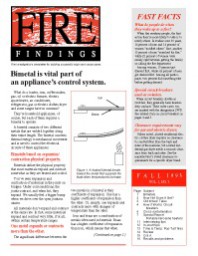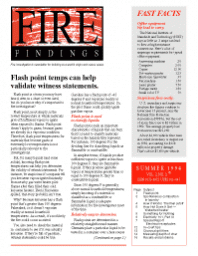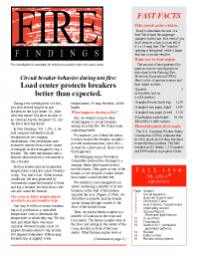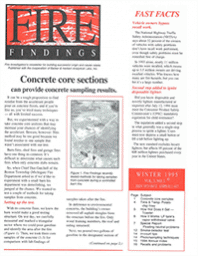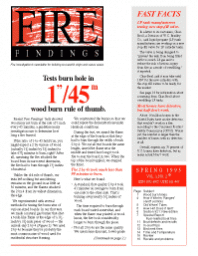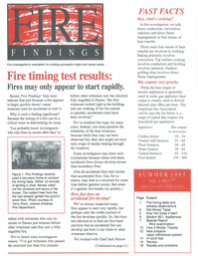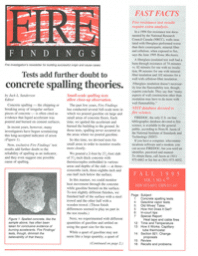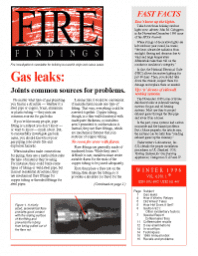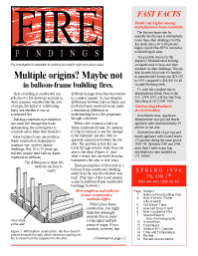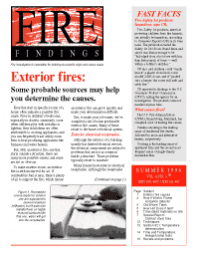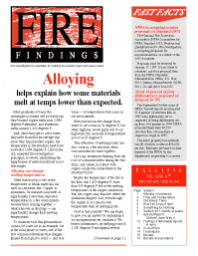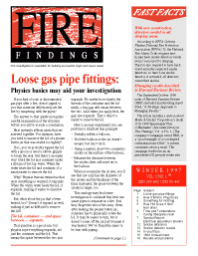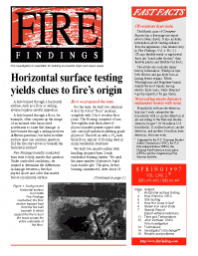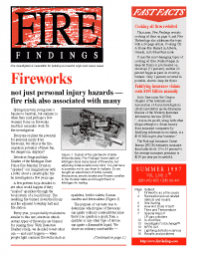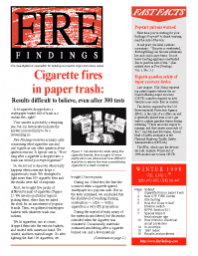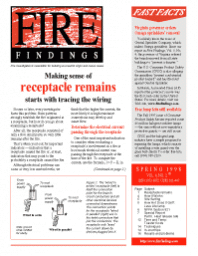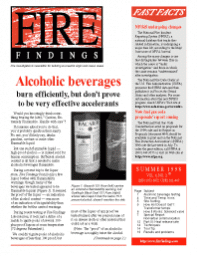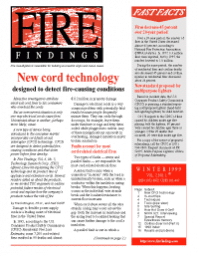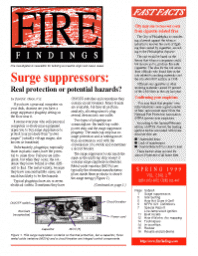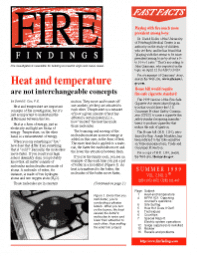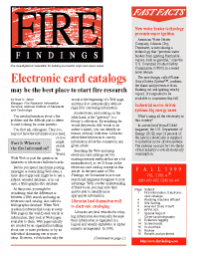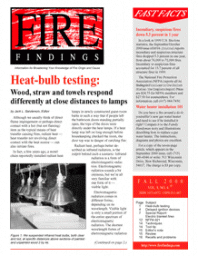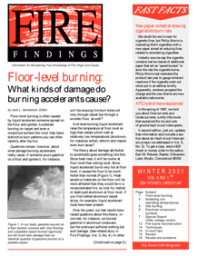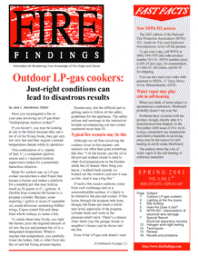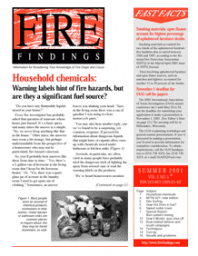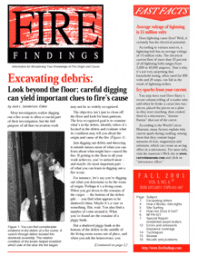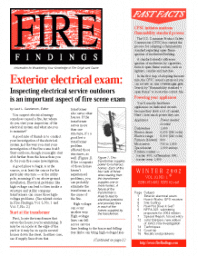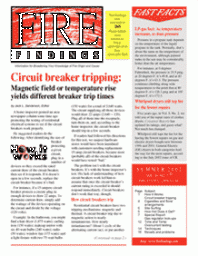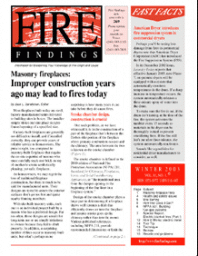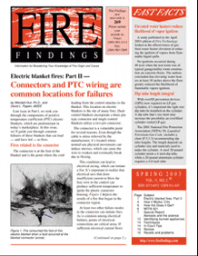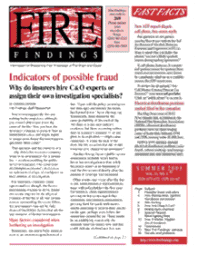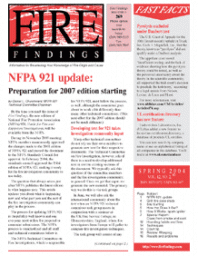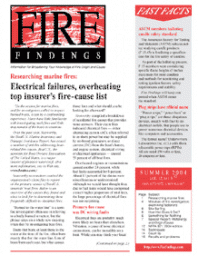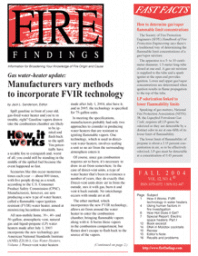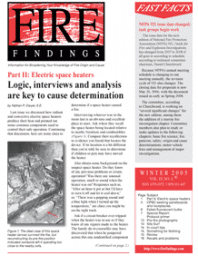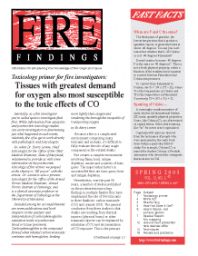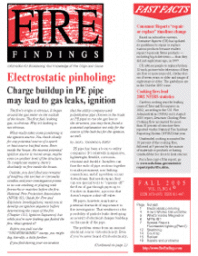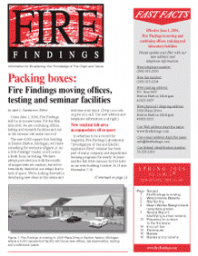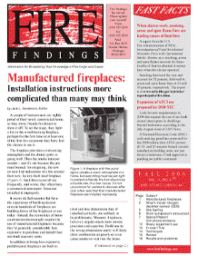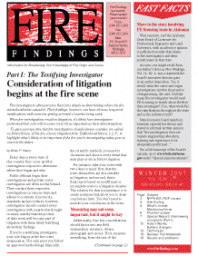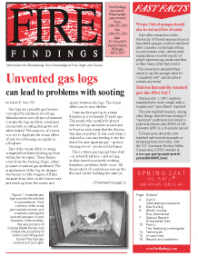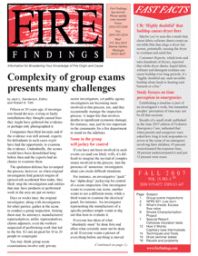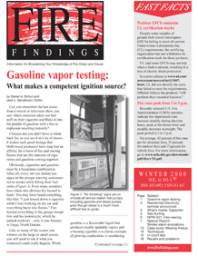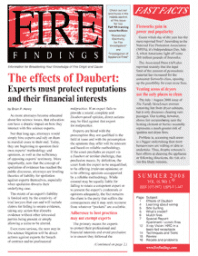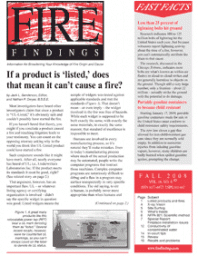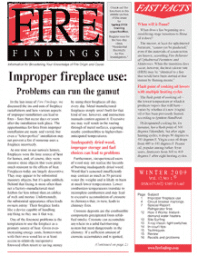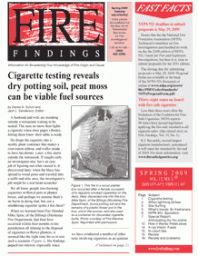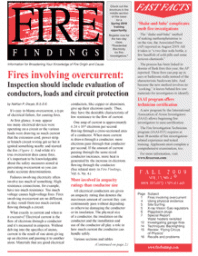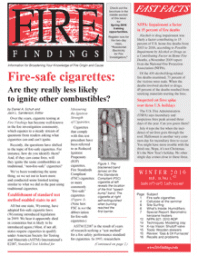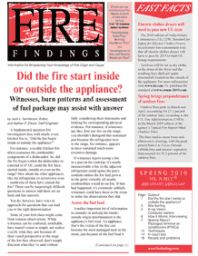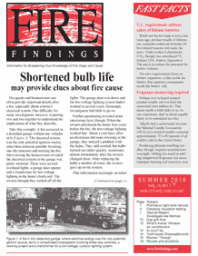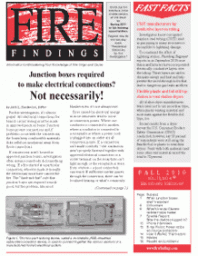Newsletter Back Issues
Each individual back issue is available for purchase. The hardcopy will be mailed to you after checkout. Shipping within the U.S. is free!
Vol. 1 No. 1
- Electric baseboard heaters are not always the fire cause culprits.
- How smoke detectors work and why they may not work.
- Operating temperatures of an electric iron.
- Electrical receptacles not in use can cause fires.
- Special Report: gas water heater fires and how a safety shutoff works.
- Kitchen fires: It pays to know what's cooking.
Price: $15.00
Vol. 1 No. 2
- Delayed ignition device: Do you have one in your home?
- Burn speed tests produce surprising results.
- Consumer Product Safety Act mandates hazard reporting.
- How hot light bulbs get.
- Special Report: residential gas regulators.
- Radiating fins in baseboard heaters key to uncovering failure.
- On-scene checklist.
Price: $15.00
Vol. 1 No. 3
- Bimetal is vital part of an appliance's control system.
- Does a curling iron get hot enough to ignite?
- Determine yourself if a circuit breaker tripped.
- Avoid cross contamination with easy-to-use methods.
- Special Report: portable kerosene heaters.
- Pop-Tarts® fuel faulty toasters and produce burning results.
Price: $15.00
All of Volume 1
Features the 3 issues published in 1993.
Price: $36.00
Vol. 2 No. 1
- Part 1: Electricity 101 for investigators.
- Tip-over switches make heaters virtually foolproof.
- How hot does a self-cleaning oven get?
- Hearth extension is an important consideration in an investigation.
- Special Report: gas furnace fires.
- Popular extension cord reels can be dangerous.
- NFPA Section 921 premieres: faulty indicators.
- Fire Findings' 1993 index.
Price: $15.00
Vol. 2 No. 2
- Spontaneous combustion not instantaneous (includes a list of common materials subject to spontaneous heating).
- How a three-way switch works.
- How hot does an air gun get?
- Part II: Electricity 101 for investigators - Computing resistance to determine current load.
- Special Report: preparing useful, easy-to-use diagrams.
- NFPA 921: Interviewing section for most inexperienced.
- Isolated product malfunctions can cause fires. (Fire Findings examines a hair dryer's quality control problem as an example.)
- Cigarette delays don't always work, but when they do...
Price: $15.00
Vol. 2 No. 3
- Flash point temps can help validate witness statements (plus a list of temps for some common flammable liquids).
- Laundry fires classic spontaneous combustion cases.
- How thermal cutoffs (TCOs) work.
- How hot does a waterbed heater get?
- Special Report: electrical receptacle fires.
- Part III: Electricity 101 for investigators -I2R formula can help determine potential for fire causes.
- Charcoal briquettes remain hot longer than 26 hours.
- NFPA 921: How to take accurate char measurements.
- Recreational boat recalls.
Price: $15.00
Vol. 2 No. 4
- Load center protects circuit breakers better than expected: An analysis of breaker behavior during a test fire.
- How hot do glue guns get?
- How transformers work.
- AC: Why it's the current of choice and how it works.
- Special Report: recessed light fixtures - how they work, fail and start fires. Includes how to examine these fixtures.
- NFPA 921: Burning under doors doesn't imply arson.
- Holiday decoration product recalls.
Price: $15.00
All of Volume 2
Features the 4 issues published in 1994.
Price: $45.00
Vol. 3 No. 1
- Concrete core sections may increase chances of identifying accelerants.
- Burn tests show one bag of potato chips fuels fire.
- How hot does a toaster get?
- How propane tank vapor withdrawal valve works.
- Special Report: floating neutrals - how to check continuity to ground and a checklist for determining the problems.
- Exclusive smoke detector burn tests: Don't make assumptions about presence of them.
- NFPA 921: fire patterns.
- Fire Findings' 1994 Index.
Price: $15.00
Vol. 3 No. 2
- Tests burn hole in '1-inch per 45-minute' wood burn rule.
- Range control analysis yields useful observations.
- How hot do fuses get?
- NFPA unveils new 921 edition that includes many changes.
- Special report: fuel-related boat fires, interviewing tips, checking for vapors or raw gas and recreational boat recalls.
- Bird nest fire hazards not just for the birds.
- Water heater main burner timing experiment and findings.
Price: $15.00
Vol. 3 No. 3
- Fire timing test results show fires may only appear to start rapidly, and what witnesses don't see can impact your cause determinations.
- Highest temps during a test fire weren't at higher levels.
- How hot do bread makers get?
- NFPA 921's appliance section doesn't address key items.
- Special report: Close-up photos and a question / answer format show you what to look for when examining wires.
- Photo examination shows you how a toaster works.
- Proposed UL Standards lead to important propane valve system safety changes.
Price: $15.00
Vol. 3 No. 4
- Test results add further doubt to the reliability of concrete spalling as an indicator.
- Other tests show gasoline doesn't cool the surface beneath it.
- Slow cookers - How hot do they get?
- Don't like portions of NFPA 921? You can do something about it.
- Special report: Noted authority, David C. Smith, explains how heat tapes and cables work and fail. He also discusses what to examine during your inspection.
- Protected area tests indicate the space under a combustible piece of furniture may not always be protected.
Price: $15.00
All of Volume 3
Features the 4 issues published in 1995.
Price: $45.00
Vol. 4 No. 1
- Gas leaks: Joints are common sources for problems.
- Relays are important parts of HVAC systems.
- Electric radiators - How hot do they get?
- NFPA 921 - Heed advice about red flags.
- Special report: Noted authority, James M. Finneran, explains how coffeemakers work and fail. Includes a list of coffeemaker recalls.
- X-rays: Nondestructive exams can lead to accurate determinations.
- Fire Findings' 1995 Index.
Price: $15.00
Vol. 4 No. 2
- Multiple origins? Maybe not in balloon-frame building fires.
- Flame rollout switch guards against elevated temperatures.
- Pop quiz: Unattended popcorn does what?
- Recently sold homes: Buyers' remorse rarely the reason for fires.
- Special Report: Gas chromatography.
- NFPA 921: Proposed canine amendment addresses concerns of improper use.
- Tests seem to cool the burning nail theory.
Price: $15.00
Vol. 4 No. 3
- Exterior fires in residential settings: Some probable sources may help you determine fire causes.
- Flame ionization detector senses presence of flame.
- Push lawn mowers get hot, but seldom cause fires.
- Physical evidence at the scene may help you discover when someone was last there.
- Special Report: Clothes dryer fires (Part I).
- NFPA 921: Accelerants raise temperatures faster, not higher.
- Reader telephone calls prompt testing on halogen lamps.
Price: $15.00
Vol. 4 No. 4
- Alloying helps explain how some materials melt at temperatures lower than expected.
- Spontaneous combustion test: Outside of linseed oil bundle was room temperature, but the inside was hot.
- How hot does a coffeemaker get?
- Special Report: Clothes dryer fires (Part II).
- NFPA 921: Safety at the scene.
- Tests put kibosh on exploding, flying can theory.
Price: $15.00
All of Volume 4
Features the 4 issues published in 1996.
Price: $45.00
Vol. 5 No. 1
- Loose gas pipe fittings: Physics basics may aid investigation.
- Plug fuses halt current almost instantly.
- Hair dryer temps make good comparisons.
- Curing fiberglass resin creates chemical reaction but no fire.
- Special Report: Electrical apparatus remains.
- Add smoke detectors to your list of potential fire causes (plus list of smoke detector recalls).
- Fire Findings' 1996 Index.
Price: $15.00
Vol. 5 No. 2
- Horizontal surface testing yields clues to fire's origin.
- Test confirms NFPA 921 saddle burn theory.
- How it Works: GFCIs compare strength of magnetic fields.
- How hot does a kitchen get?
- Case study: Tracing internal wiring of electric iron irons out melting mystery.
- Special Report: Expert Witness Testimony.
- Time and Temp: Can twisting, squeezing and compressing a conductor cause a fire?
- Interview with Kirk's Fire Investigation author, John D. DeHaan, Ph.D.
- NFPA 921: Examining slopes of holes may help find fire source.
Price: $15.00
Vol. 5 No. 3
- Fireworks not just personal injury hazards - fire risks associated with many.
- Recreational boat-related defects and recall campaigns.
- How hot does a heating pad get?
- Electric range tests produce similar results to 1993 gas range experiment.
- Special Report: LP gas cylinders, plus news on the new overfill prevention device.
- Lightning detection service monitors strikes within 1,500-foot radius.
Price: $15.00
Vol. 5 No. 4
- Medium petroleum distillates - These ignitable liquids may or may not be accelerants. (Plus a chart of ignitable liquid residues' classifications.)
- Study in refraction is a reminder of what light can do.
- How hot does a charcoal-firewood starter get?
- Crematorium tour aids fire death investigation.
- Special Report - candle fires. Plus, ASTM, NCA and CPSC initiate voluntary standard talks.
- NFPA 921 - A total burn" fire scene may not be a complete loss.
- Sprinkler heads typically one of two designs.
- Training materials and certification are useful tools for wood stove and fireplace investigations.
- ""p>• Medium petroleum distillates - These ignitable liquids may or may not be accelerants. (Plus a chart of ignitable liquid residues' classifications.)
- Study in refraction is a reminder of what light can do."
Price: $15.00
All of Volume 5
Features the 4 issues published in 1997.
Price: $45.00
Vol. 6 No. 1
- Cigarette fires in paper trash: Results difficult to believe, even after 300 tests.
- New Bureau of ATF FIRE Center slated.
- How hot does a dimmer switch get?
- Burn patterns on floors may not indicate arson.
- Special Report: heat release rate (Part I).
- Circuit protection devices respond differently depending on situation.
- Fire Findings' 1997 index.
Price: $15.00
Vol. 6 No. 2
- Making sense of electrical receptacle remains starts with tracing wiring.
- How hot does a lava lamp get?
- Updated NFPA 921 guide published.
- Special Report: heat release rate (Part II).
- Using scientific calculators to compute flame heights, heat release rates.
- Determining heat release rates using flame heights (chart shown in meters and feet).
- Toaster pastry update: Only two boxes included fire-risk caution.
Price: $15.00
Vol. 6 No. 3
- Alcoholic beverages burn efficiently, but don't prove effective accelerants.
- What happens when you leave a hot iron on fabric?
- How hot does a transformer get?
- Solenoid valve uses electricity to control gas flow.
- Special Report: Nonverbal communication plus body language tips.
- Heat release rate and flashover (Part III).
Price: $15.00
Vol. 6 No. 4
- Clothes dryer lint: Spontaneous heating doesn't occur in any of 16 tests.
- Electric iron update: A week later, it still didn't start a fire.
- Electrical conductor temps stay low in insulation, but different conditions could lead to ignition.
- NFPA 921: New video series excellent accompaniment to 921 guide.
- Special Report: gas explosions.
- Split coil gas burner has few parts, but is a complex system.
Price: $15.00
All of Volume 6
Features the 4 issues published in 1998.
Price: $45.00
Vol. 7 No. 1
- New cord fault circuit interrupter (CFCI) technology designed to detect fire-causing conditions.
- Cord abuse testing leads to higher temps, internal arcing.
- New Dex Wipe Warmer’s temps much lower than recalled product.
- NFPA 921: Tape recording statements doesn’t need to be distracting or annoying.
- Special Report: Eyewitness Memory / Interviewing Tips / Swiss Nanny arson-murder case.
- Part II — Clothes dryer lint: Testing reaffirms spontaneous heating of lint is unlikely.
- Fire Findings’ 1998 index.
Price: $15.00
Vol. 7 No. 2
- Surge suppressors: Real protection or potential hazards?
- How hot does a natural gas-fired water heater get?
- NFPA 921: Mastering definitions not a waste of time.
- Special Report: Low-temperature wood ignition.
- Boat-related defects and recall campaigns.
- Arc mapping can provide valuable clues of fire's origin.
- Arcing in conduit generally a result of the fire.
Price: $15.00
Vol. 7 No. 3
- Heat and temperature are not interchangeable concepts (includes 'specific heat' values of some common substances).
- NFPA 921: Prepare today for opposing counsel’s questions.
- How Hot Does It Get — self-heating meals.
- Special Report: Electric system operations and power 'surges'.
- Part II: Surge suppressors’ voltages, components and quality vary.
- High resistance connection may be fire-causing culprit, too.
Price: $15.00
Vol. 7 No. 4
- Electronic card catalogs good place to start research.
- Washing machine effluent may provide clues in dryer fire investigations.
- Glowing electrical connections’ study revisited.
- Special Report: Close-up photography.
- NFPA 921: Does it matter when you choose to interview?
- More involved in evidence tagging than meets the eye.
- Noting product fasteners’ history of use can be helpful.
Price: $15.00
All of Volume 7
Features the 4 issues published in 1999.
Price: $45.00
Vol. 8 No. 1
- Prefabricated chimneys: Proper installation and precautions reduce risks associated with use.
- Ceramic heater acts fast when overheated.
- Special Report: Part I. Panelboard examinations.
- NFPA 921: Proposed changes to next edition could have substantial impact.
- Insulation analysis: Cellulose and mineral wool look deceptively alike but similarity stops there.
- Learning to narrow Web results can be the key to successful on-line searching.
Price: $15.00
Vol. 8 No. 2
- Part II: Panelboard examinations.
- New electric range’s coils heat faster and hotter.
- InterFIRE VR well worth the wait.
- Special Report: Examining switches, including meter makes short work of testing for electrical continuity.
- Arc-fault circuit interrupter (AFCI): New device protects against electrical arcing.
Price: $15.00
Vol. 8 No. 3
- Carbon tracking: Poor insulation, contaminants make for potential fire cause.
- NFPA 921: Technical committee affirms controversial proposals.
- LP-gas, natural gas grills reach similar temperatures.
- Newer toaster technology uses electronics instead of bimetals for timers.
- Special Report — Burn tests: ignition elevations of first fuels and fire origins.
- Novelty lamps: potential fire causes?
- Cutler-Hammer self-study courses introduce electrical fundamentals.
Price: $15.00
Vol. 8 No. 4
- Heat-bulb testing: Wood, straw and towels respond differently at close distances to lamps.
- Delayed ignition devices: Legendary balloon and gasoline device sounds better than it performs; without a timer, others don't have much delay.
- Special Report: Electric blanket fires.
- NFPA 921: Negative corpus, other proposals change for final draft of next edition.
Price: $15.00
All of Volume 8
Features the 4 issues published in 2000.
Price: $45.00
Vol. 9 No. 1
- Floor-level burning: What kinds of damage do burning accelerants cause?
- How Hot Does It Get: soldering iron operating temperatures.
- Uniform symbols to use for diagramming electrical systems.
- Special Report: Utility voltage control.
- NFPA 921: fire scene reconstruction and prefire positioning.
Price: $15.00
Vol. 9 No. 2
- Outdoor LP-gas cooker testing: Just-right conditions can lead to disastrous results.
- Lighting at the fire scene (flashlights).
- How hot does candle wax get?
- NFPA 921: interpreting electrical wire damage.
- Special Report: electrical apparatus remains revisited.
- Halogen work-light testing.
Price: $15.00
Vol. 9 No. 3
- Household chemicals: Warning labels hint of fire hazards, but are they a significant fuel source?
- NFPA 921: New edition's additions and updates (2001 edition premieres).
- Hot rollers' operating temperatures.
- Swivel outlet cover: Receptacle aimed at safety may prove otherwise.
- Special Report: burn pattern testing (V-patterns).
- How it Works: automatic shut-off mechanisms.
- Boat defects and recalls.
Price: $15.00
Vol. 9 No. 4
- Excavating debris — look beyond the floor for important clues to fire's cause.
- Holiday mini-lights (how they work) — shunt begins operating when filament breaks or burns out.
- Scorched battery charger leads to testing (how hot does it get).
- NFPA 921: additions to other evidentiary factors" section takes 921 into new territory.
- Special Report: residential steam boilers.
- Errors and omissions coverage can protect from financial disaster.
- ""p>• Excavating debris — look beyond the floor for important clues to fire's cause.
- Holiday mini-lights (how they work) — shunt begins operating when filament breaks or burns out.
- •"
Price: $15.00
All of Volume 9
Features the 4 issues published in 2001.
Price: $45.00
Vol. 10 No. 1
- Exterior electrical exams: Important aspect of fire scene exam.
- WAAS-enabled GPS receives may have applications for larger fire-scene work.
- Operating temperatures of a multi-cooker (countertop deep-fat fryer).
- Input for 2004 edition of NFPA 921 due soon.
- Special Report: Forced Entry.
- Kirk's author, John DeHaan, adds to V-pattern discussion (excerpt of new edition also included).
Price: $15.00
Vol. 10 No. 2
- Bystander videos: Using them intelligently may strengthen your investigations.
- Knob-and-tube wiring installations: how they work.
- Toaster oven operating temperatures and hazards.
- NFPA 921: Depth of char analysis.
- Special Report: Candle Fires Update.
- Part I: Water heater testing — varying the air supply.
Price: $15.00
Vol. 10 No. 3
- Circuit breaker tripping: magnetic field or temperature rise yields different breaker trip times.
- With the flick of a cigarette, floral arrangments are set afire.
- FryDaddy (electric deep fryer) operating temperatures.
- NFPA 921: Incendiary indicators ('too hot,' 'too fast' not among those listed).
- Special Report: gas regulator lock-ups plus how to test regulator pressure.
- Overcurrent testing: small temp increases fail to damage conductors, let alone create fire-causing conditions.
Price: $15.00
Vol. 10 No. 4
- Furnace ignition systems: High-efficiency technology brings variances among manufacturers.
- NFPA 921: Working with the scientific method a basic tool of today's investigations.
- Operating temperatures of the George Foreman Lean Mean Fat Reducing Grilling Machine."
- How it Works: A gas shutoff valve leaks after the fire — here's why.
- Special Report: Ignitable Liquid Classification Update (ASTM International E 1387 and E 1618).
- Prevailing winds: Structures can significantly block or alter wind direction.
- ""p>• Furnace ignition systems: High-efficiency technology brings variances among manufacturers.
- NFPA 921: Working with the scientific method a basic tool of today's investigations.
- Operating temperatures of the George Foreman "Lean Mean Fat Reducing Grilling Machine."
- How it Works: A gas"">• Furnace ignition systems: High-efficiency technology brings varia"
Price: $15.00
All of Volume 10
Features the 4 issues published in 2002.
Price: $45.00
Vol. 11 No. 1
- Masonry fireplaces: Improper construction years ago may lead to fires today.
- Occupational health and safety: Risks still present after fire extinguishment.
- Roof de-icing cable requires extra care (operating temperatures test).
- Look for fuel gas as an influence on fire development or as a cause.
- Special Report: electric blanket fires (Part I) plus how to handle, preserve crucial components.
- How the mechanical electric meter works.
Price: $15.00
Vol. 11 No. 2
- Electric blanket fires — common failures (Part II).
- Updated curriculum vitae (CV) essential part of being an expert witness.
- Salamander heater (portable forced-air heater) operating temperatures.
- NFPA 921: evaluating low burn patterns.
- Special Report: aerosols and fire science.
- Identifying the age, manufacturer of burned mystery" appliances.
- ""p>• Electric blanket fir"
Price: $15.00
Vol. 11 No. 3
- Indicators of insurance fraud.
- Ignition Handbook by Vytenis Babrauskas.
- Heating pad comparisons and operating temperatures.
- Southwest Mobile Storage burn chamber.
- Special Report: Neon lighting fires.
- Tripped circuit breakers after a fire: what they mean.
Price: $15.00
Vol. 11 No. 4
- Attorney questionnaire: Investigators should evaluate cases honestly and prepare totally.
- Language Line Services: interpreter services.
- How Hot Does it Get? Incandescent nightlight.
- ATF National Laboratory Center.
- Special Report: Juvenile firesetting.
- NFPA 921: surface effect statement.
Price: $15.00
All of Volume 11
Features the 4 issues published in 2003.
Price: $45.00
Vol. 12 No. 1
- Voltage required to cause arcs and sparks.
- LP-gas tank top heater operating temperatures.
- NFPA 921: User's Manual premieres.
- Special Report: methamphetamine lab fires.
- Alarm systems: gaining crucial info after a fire.
Price: $15.00
Vol. 12 No. 2
- NFPA 921: Preparation for 2007 edition starts plus proposal-writing tips.
- Case study: Keep the gas grill clean and off a wood deck (blocked venturi tubes leading to fires).
- How it Works: gas grill igniter.
- Hair straightener operating temperatures.
- Special Report: clues from smoke stains and soot.
- Poor housekeeping out of control: hoarders' collections and the risk of fire.
Price: $15.00
Vol. 12 No. 3
- Researching marine fires: Electrical failures and overheating top insurer's fire-cause list.
- Minutiae of fire investigation: What wall covering was in use?
- Dishwasher heating element's operating temperatures.
- Special Report: metallurgy and origin/cause.
- NFPA 921: 2004 edition arrives with important changes.
Price: $15.00
Vol. 12 No. 4
- Gas water heaters and new flammable vapor ignition resistant (FVIR) technology.
- Assessing human factors in product design.
- Special Report: electric space heaters.
- Using building features to evaluate burn patterns (Fire Scene Reconstruction, book excerpt).
- Testing Molotov cocktails for DNA.
Price: $15.00
All of Volume 12
Features the 4 issues published in 2004.
Price: $45.00
Vol. 13 No. 1
- Electric space heaters (Part II): Clues to determining if this appliance caused a fire.
- CPSC seeking electrical panelboards and receptacles involved in fires.
- Melted fluorescent light bulb and recall of them.
- Special Report: Protocol primer.
- Using pre-fire photographs to capture essence of burned structures.
Price: $15.00
Vol. 13 No. 2
- Toxicology primer for fire investigators.
- NFPA 921: tracking changes from edition to edition.
- Propane torch operating temperatures.
- How it Works: hot surface igniters for gas ovens.
- Special Report: basics of arc mapping.
- Inspecting ground-fault protection (GFP) devices after a fire.
Price: $15.00
Vol. 13 No. 3
- Careful exterior inspection can aid determination process.
- How a power-vent water heater works.
- New column premieres: What's Inside -- this issue we cover wall-mounted thermostats.
- NFPA 921: The case of the overdriven or misdriven staple.
- Special Report: fluorescent lighting (Part I).
- Conductors 101: Learning properties and sizing techniques can help identify device, maker.
Price: $15.00
Vol. 13 No. 4
- Electrostatic pinholing: Charge buildup in PE pipe may lead to gas leaks, ignition.
- How it Works: dehumidifier.
- What's Inside: microwave magnetron.
- NFPA 921 and confirmed incendiary fires: Serial arson clues may lie in other types of fires.
- Special Report: fluorescent lighting (Part II).
- Sketching: A valuable tool if done early in an investigation.
Price: $15.00
All of Volume 13
Features the 4 issues published in 2005.
Price: $45.00
Vol. 14 No. 1
- A matter of inches: Slight changes in variables make a difference in resulting test fires.
- How instant-demand (tankless) water heaters work.
- Wire nuts, aka pressure-type wire connectors, are tiny parts that perform a big job in any wiring project.
- Special Report: high-efficiency gas furnaces.
- When flame-rollout leads to fires.
Price: $15.00
Vol. 14 No. 2
- Fire Findings moving its offices, testing and seminar facilities.
- What's Inside: Bakelite still recognizable after a fire.
- How it Works: Multitude of receptacle grades available, but U.S. specifies few straight blade grades.
- Special Report: Clues to identifying remains.
- Returning to the scene: Preparation is key to making good use of time.
- Editor's Note: Daubert and dinosaurs.
Price: $15.00
Vol. 14 No. 3
- Aging a house: Knowledge of materials may help determine decade of construction.
- Video surveillance camera: Technology advancements make canvassing efforts worthwhile.
- What's Inside: Infinite control switch.
- NFPA 921: Fire-related human behavior.
- Special Report: Origin determination primer.
- How it Works: Spa systems.
Price: $15.00
Vol. 14 No. 4
- Manufactured fireplaces: Installation instructions more complicated than you think.
- What's Inside: oxygen depletion sensor.
- Investigating Residential Dryer Fires: April 2007 symposium.
- Special Report: cell phone evidence.
- Using heavy equipment at the scene.
Price: $15.00
All of Volume 14
Features the 4 issues published in 2006.
Price: $45.00
Vol. 15 No. 1
- Part I: The Testifying Investigator - Consideration of litigation begins at the scene.
- NFPA 921: Committee issues proposal report.
- What's Inside: Mechanical timer controls operation of appliance.
- Phantom power: devices turned off" may create fire hazards.
- Special Report: Interviewing occupants (Part I).
- How it Works: Battery chargers.
- ""p>• Part I: The Testifying Investigator - Consideration of litigation begins at the scene.
- NFPA 921: Committee issues pro"
Price: $15.00
Vol. 15 No. 2
- Unvented logs can lead to soot problems.
- Part II: The Testifying Investigator - Knowing what and when to report is central part of investigative process.
- What's Inside: Bias thermostat makes lower temperature possible in a clothes dryer.
- Special Report: Dishwasher fires.
- Interviewing occupants (Part II).
Price: $15.00
Vol. 15 No. 3
- Cigarette fires in fabrics: After 500 tests, results may be difficult to fathom.
- States step up to enact "fire-safe" cigarette legislation.
- NFPA 921: Wildfire chapter applies to more than wildland fires.
- What's Inside: incandescent and halogen bulbs.
- DeHaan makes substantive changes to new edition of Kirk's Fire Investigation.
- Special Report: Arc mapping follow up.
- How It Works: air conditioning systems.
Price: $15.00
Vol. 15 No. 4
- Taking on the challenge of group fire scene exams and tips for streamlining inspections.
- NFPA 921: Low burn not proof of an incendiary fire.
- What's Inside: excess flow valve.
- Smoke Characterization Project and the significance behind the findings for fire investigators.
- Special Report: cellulose insulation tests.
- How it Works: capillary tube thermostat.
Price: $15.00
All of Volume 15
Features the 4 issues published in 2007.
Price: $45.00
Vol. 16 No. 1
- Gasoline vapor testing: What makes a competent ignition source?
- Residential Electricity for Fire Investigators: New Fire Findings seminar makes debut.
- What's Inside: capacitor motor.
- NFPA 921: Addition of guidelines could improve interviewing section.
- Special Report: smoke alarm evaluations.
- Case study: The Missing Firebox.
Price: $15.00
Vol. 16 No. 2
- Unfused lines at the service entrance make for potential ignition source.
- Compact fluorescent lights warrant caution in some instances.
- NFPA 921: Changes to origin determination chapter may have impact.
- Special Report: cooktop control analysis.
- How It Works: Today's notes make tomorrow's testimony noteworthy.
Price: $15.00
Vol. 16 No. 3
- The effects of Daubert: Experts must protect reputations and financial interests.
- When wiring is an issue, arm yourself with knowledge.
- What's Inside: the basic box or pedestal fan.
- Type of mulch and lighting may be important to scene exam.
- Special Report: Apartment / condominium fires.
- Case study: Can a high resistance connection lead to a fire even after a load is removed?
Price: $15.00
Vol. 16 No. 4
- If a product is "listed," does that mean it can't cause a fire?
- UL offers variety of product testing services.
- Create "grids" to X-ray larger masses of burned debris.
- What's Inside: Heat tape and heat cable are not the same.
- NFPA 921: "Inductive reasoning" moved in latest edition.
- Special Report: Fireplace installation issues.
- Contaminated water + electricity = potential fire hazard.
Price: $15.00
All of Volume 16
Features the 4 issues published in 2008.
Price: $45.00
Vol. 17 No. 1
- Improper fireplace use: problems run the gamut.
- What do the markings on circuit breakers mean?
- Special Report: Refrigerator fires.
- How it Works: Instant-demand gas water heater.
- Was the switch on or off? X-rays may provide the answer.
Price: $15.00
Vol. 17 No. 2
- Testing lit cigarettes in potting soil and peat moss.
- Verification of lightning data and the role of the fire investigator.
- What's Inside: air freshener heating element.
- NFPA 921: spoliation material.
- Special Report: anticipating the fire scene.
- How it Works: operation of a pellet stove.
- X-ray Vision: small fuses (overcurrent protection device).
Price: $15.00
Vol. 17 No. 3
- NFPA 921: Q & A interview with Chairman Randy Watson.
- What's Inside: power strip aka relocatable power tap (RPT).
- Experimenting with expanding foam insulation and fire potential.
- Special Report: reflective radiant barriers.
- How it Works: heating elements are workhorses" of electric appliances.
- ""p>• NFPA 921: Q & A interview with "
Price: $15.00
Vol. 17 No. 4
- Overcurrent: Evaluation should include evaluation of conductors, loads and circuit protection (checklist included).
- Using physical evidence to prove – or disprove – a witness' credibility.
- X-ray Vision: gas regulators.
- "Piggyback plug": Blades and fuses make it uniquely different.
- Special Report: water heaters revisited.
- Garage fires: Challenges are many when investigating.
Price: $15.00
All of Volume 17
Features the 4 issues published in 2009.
Price: $45.00
Vol. 18 No. 1
- Fire-safe cigarettes: Are they really less likely to ignite other combustibles?
- Cellulose at the seminar: Attendees get unexpected bonus" with wood-burning stove demonstration.
- What's Inside: Humidifiers.
- Special Report: Barometric kerosene heaters.
- NFPA 921: Time to comment on proposals for 2011 edition.
- X-ray Vision: Gas shutoff – was it open or closed?
- ""p>• Fire-safe cigarettes: Are they really less likely to ignite other combustibles?
- Cellulose at the seminar: Attendees get unexpected "bonus" with wood-burning stove demonstration.
- What's Inside: Humidifiers.
- Special Report: Barometric "">• Fire-safe cigarettes: Are they really less likely to ignite other combustibles?
- Cellulose at the seminar:"
Price: $15.00
Vol. 18 No. 2
- Did the fire start inside or outside appliance? Witnesses, burn patterns and assessment of fuel package may assist.
- X-ray Vision: Computer batteries – despite recalls, complete analysis still required.
- How it Works: Interviewing not just about the questions themselves.
- Special Report: Packaged terminal air conditioners (PTAC).
- NFPA 921: Definitions chapter evolves with the rest of NFPA document.
Price: $15.00
Vol. 18 No. 3
- Shortened bulb life may provide clues about fire cause.
- Cellulose insulation testing continues: What happens when it comes in contact with hot surfaces?
- Special Report: Investigate like Holmes.
- Gas grill fires: Type of fire can vary depending on a number of factors, including amount of use.
- What's Inside: Window air conditioner.
Price: $15.00
Vol. 18 No. 4
- Junction boxes not necessarily required to make electrical connections.
- Oil furnaces and other oil-fueled appliances require burning the fuel oil just right.
- What's Inside: Radiator-style heater.
- Special Report: Was the device plugged in?
- How to make the most of a phone interview.
- X-ray Vision: Power strips and surge suppressor radiographs may provide important information.
- How it Works: Thermistors.
Price: $15.00
All of Volume 18
Features the 4 issues published in 2010.
Price: $45.00




